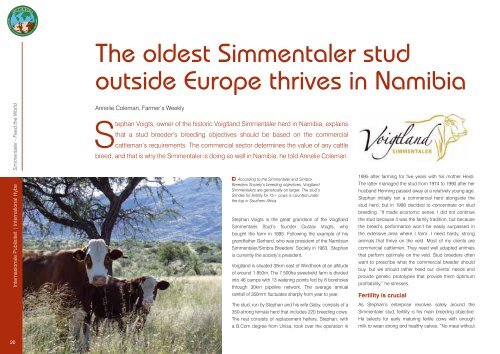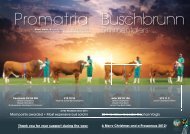Simmentaler Joernaal 2013.indb
Simmentaler Joernaal 2013.indb
Simmentaler Joernaal 2013.indb
Create successful ePaper yourself
Turn your PDF publications into a flip-book with our unique Google optimized e-Paper software.
<strong>Simmentaler</strong> - Feed the World<br />
Internasionale Publisiteit | International Hybe<br />
20<br />
The oldest <strong>Simmentaler</strong> stud<br />
outside Europe thrives in Namibia<br />
Annelie Coleman, Farmer’s Weekly<br />
Stephan Voigts, owner of the historic Voigtland <strong>Simmentaler</strong> herd in Namibia, explains<br />
that a stud breeder’s breeding objectives should be based on the commercial<br />
cattleman’s requirements. The commercial sector determines the value of any cattle<br />
breed, and that is why the <strong>Simmentaler</strong> is doing so well in Namibia, he told Annelie Coleman.<br />
According to the <strong>Simmentaler</strong> and Simbra<br />
Breeders Society’s breeding objectives, Voigtland<br />
<strong>Simmentaler</strong>s are genetically on target. The stud’s<br />
Simdex for fertility for 75+ cows is counted under<br />
the top in Southern Africa.<br />
Stephan Voigts is the great grandson of the Voigtland<br />
<strong>Simmentaler</strong> Stud’s founder Gustav Voigts, who<br />
bought the farm in 1895. Following the example of his<br />
grandfather Gerhard, who was president of the Namibian<br />
<strong>Simmentaler</strong>/Simbra Breeders’ Society in 1963, Stephan<br />
is currently the society’s president,<br />
Voigtland is situated 35km east of Windhoek at an altitude<br />
of around 1 850m. The 7 500ha sweetveld farm is divided<br />
into 46 camps with 13 watering points fed by 8 boreholes<br />
through 30km pipeline network. The average annual<br />
rainfall of 350mm fluctuates sharply from year to year.<br />
The stud, run by Stephan and his wife Gaby, consists of a<br />
350-strong female herd that includes 220 breeding cows.<br />
The rest consists of replacement heifers. Stephan, with<br />
a B.Com degree from Unisa, took over the operation in<br />
1995 after farming for five years with his mother Heidi.<br />
The latter managed the stud from 1974 to 1990 after her<br />
husband Henning passed away at a relatively young age.<br />
Stephan initially ran a commercial herd alongside the<br />
stud herd, but in 1998 decided to concentrate on stud<br />
breeding. “It made economic sense. I did not continue<br />
the stud because it was the family tradition, but because<br />
the breed’s performance won’t be easily surpassed in<br />
the extensive area where I farm. I need hardy, strong<br />
animals that thrive on the veld. Most of my clients are<br />
commercial cattlemen. They need well adapted animals<br />
that perform optimally on the veld. Stud breeders often<br />
want to prescribe what the commercial breeder should<br />
buy, but we should rather heed our clients’ needs and<br />
provide genetic prototypes that provide them optimum<br />
profitability,” he stresses.<br />
Fertility is crucial<br />
As Stephan’s enterprise revolves solely around the<br />
<strong>Simmentaler</strong> stud, fertility is his main breeding objective.<br />
He selects for early maturing fertile cows with enough<br />
milk to wean strong and healthy calves. “No meat without



